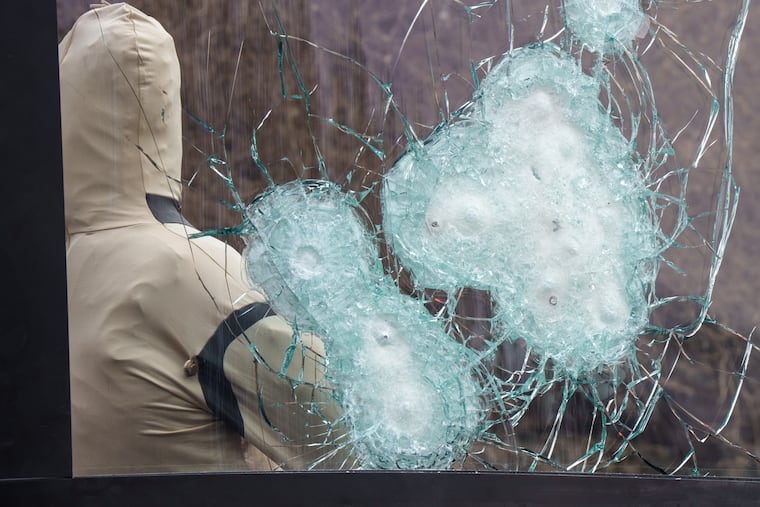A SWAT team shot up SEPTA’s new protective cockpit for bus drivers. It passed the test.
SEPTA will be the first U.S. transit agency install bullet-resistant glass to protect bus operators.

Tim the Crash-Test Dummy survived 16 bullets that thudded into ballistic glass inches from his head. The shots were fired in a tight pattern by a pair of onrushing Bucks County SWAT team officers simulating an attack on a transit bus operator.
When the smoke cleared, one flattened .45 caliber slug dangled from Tim’s silk shirt, at the shoulder.
“This driver would be alive and well, [and] in a lot of cases probably uninjured,” said Chad Beach, director of product management for manufacturer Custom Glass Solutions.
The company has developed prototypes of a reinforced cockpit to protect SEPTA bus operators, working over the last 15 months with the transit agency’s engineers and Transport Workers Union Local 234, which represents the drivers.
SEPTA plans to deploy the enclosures on eight buses during the spring, a response to a surge in assaults on operators in recent years. It would be the first U.S. transit agency to install bullet-resistant glass.
Dozens of transit union officials, including many bus operators, from around the nation flocked to a police firing range in Pipersville on Tuesday for a series of live-fire exercises to demonstrate the technology.
Eight shots flew at the dummy from a .45-caliber handgun and another eight from a 9-millimeter during the rush to the cockpit — fired at the same time and concentrated at the same spot from a distance of about 10 feet.
Beach called it a test of an extreme situation, noting that it is unlikely that a random attack by nonprofessionals would deliver so much firepower so accurately.
“What we talk about in ballistics is a less-than-lethal pass-through,” Beach said. The glass slowed the .45 bullet, and it penetrated the other side at a low rate of speed, he said.
Earlier, the SWAT team blasted samples of ballistic glass panes with firearms of varied power. Everything was stopped, though .357 ammo left a slight bulge — about the size and shape of a big mosquito bite — on the back side of the glass.
“We’ll take it,” said Brian Pollitt, president of Local 234. “This is a great day for mass transit.”
‘We’re all by ourselves’
A rising number of assaults by passengers over the past 15 years has made operating a bus ever more dangerous; attacks skyrocketed in 2020 and continued.
“We’re all by ourselves and wait for the police to come. Sometimes the police don’t come until all of the blood has been shed,” said Fidel Minor, a 29-year bus operator from Houston who is now a vice president of TWU Local 260, representing members with formal grievances.
He said he has been in a couple of fights over his career. Drivers have been injured in Houston, as elsewhere, by fists, knives, and blunt objects, and by toxic substances or full beverage containers thrown at them. Gunshots are rarer, but a persistent fear.
“We need to have politicians that are going to make sure that they protect public transportation and operators, [who are] the most important safety feature on a bus,” Minor said. “Don’t talk about it, but be about it. I’m tired of hearing sermons.”
He and the other attendees crowded around to marvel at the spiderwebbed glass, designed to flex, stop, or disrupt a bullet’s path and prevent flying glass pieces.
Besides Houston, they came from New York; Miami; Charlotte, N.C; Columbus, Ohio; Akron, Ohio; and Ann Arbor, Mich.
For SEPTA and its frontline workers, the search for greater safety gained urgency in late October 2023 when bus operator Bernard N. Gribbin was shot to death while driving his morning route in Philadelphia’s Germantown section.
SEPTA buses have been fired on deliberately and hit by stray bullets, including four shootings within a week last March in Philadelphia. Other assaults on bus operators — physical and verbal — jumped during the pandemic and have remained higher than normal.
No substitute for road testing
Inside the Berridge Shop on Wyoming Avenue in Feltonville, Custom Glass Solutions, SEPTA engineers, and TWU Local 234 experts have been working on a stripped-down bus to get the first compartment right.
Adjustments have been made in the design, with the prototypes shuttling between the company’s factory in Trumbauersville, Pa. (near Quakertown), and the shop in Philadelphia.
“We have to make sure it attaches [well] to the bus floor, that it doesn’t move if the operator has to brake suddenly,” said Ron Newman of TWU Local 234, cochair of the joint safety committee of union representatives and SEPTA management.
The working group also had to design proper ventilation for the enclosed cabin; the transit agency wanted it positioned to allow even more room at the front of the bus than required by the Americans with Disabilities Act and to protect against a gunshot that could pass through the electronics box behind the driver’s seat.
And the group also is trying to estimate how a 400-pound cockpit could affect a bus’ suspension.
“It takes awhile. We’re not done yet,” Newman said.
There’s no substitute for road testing to discover what happens when a heavier bus hits Philadelphia-area potholes and how comfortable operators are working in the cockpits, SEPTA spokesperson Andrew Busch said.
SEPTA’s plans for a wider installation are unclear, Busch said, adding that the agency will need to decide whether to retrofit older buses in the fleet, require the cabins on new buses — SEPTA buys about 120 per year — or a combination.
One more thing, please don’t call the innovation bulletproof. Nothing truly is — even a six-inch thick ballistic window on an Army tank — if hit by a shell at close range, said Tony Ricci, business development manager for Custom Glass Solutions.
“We call it transparent armor,” he said.